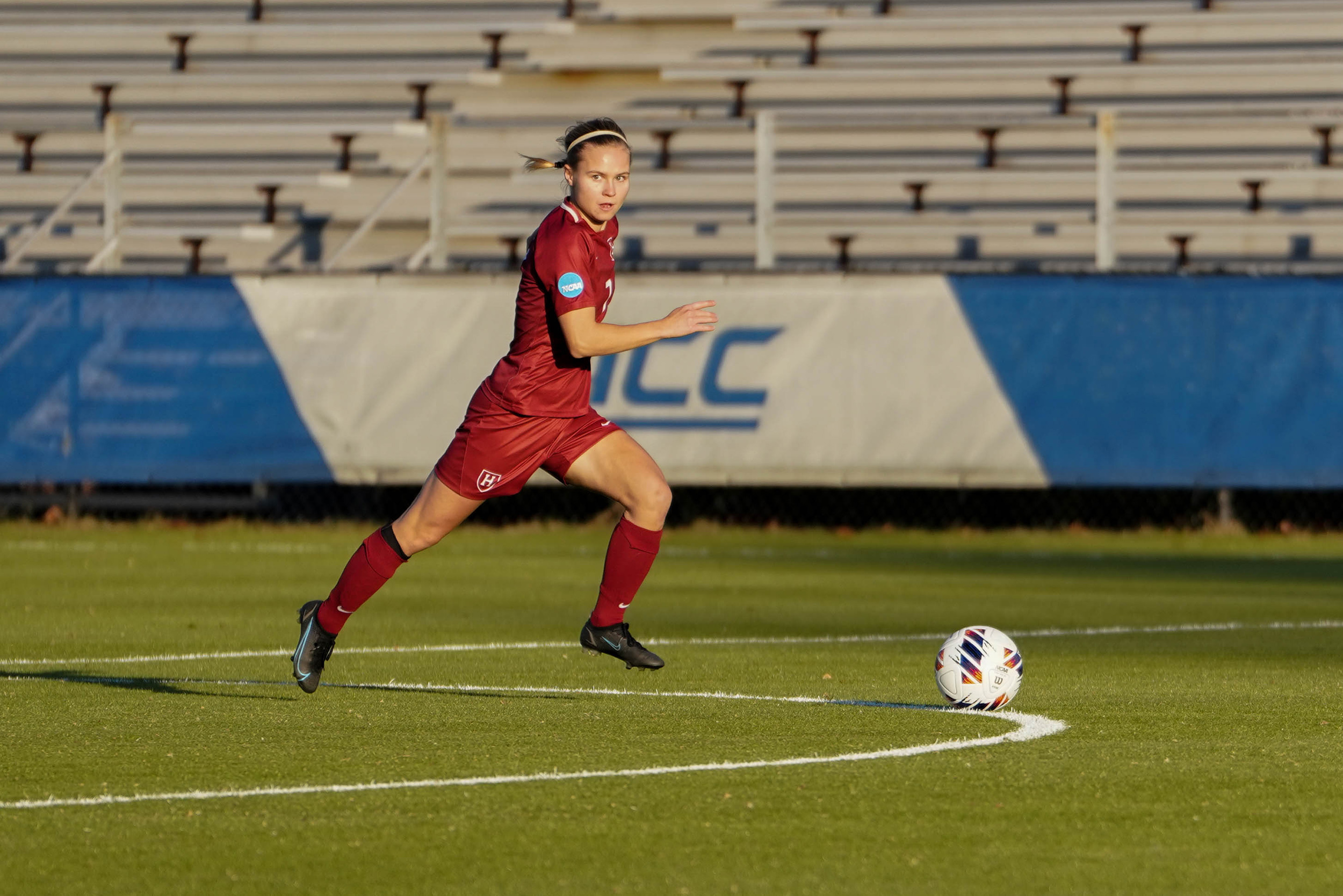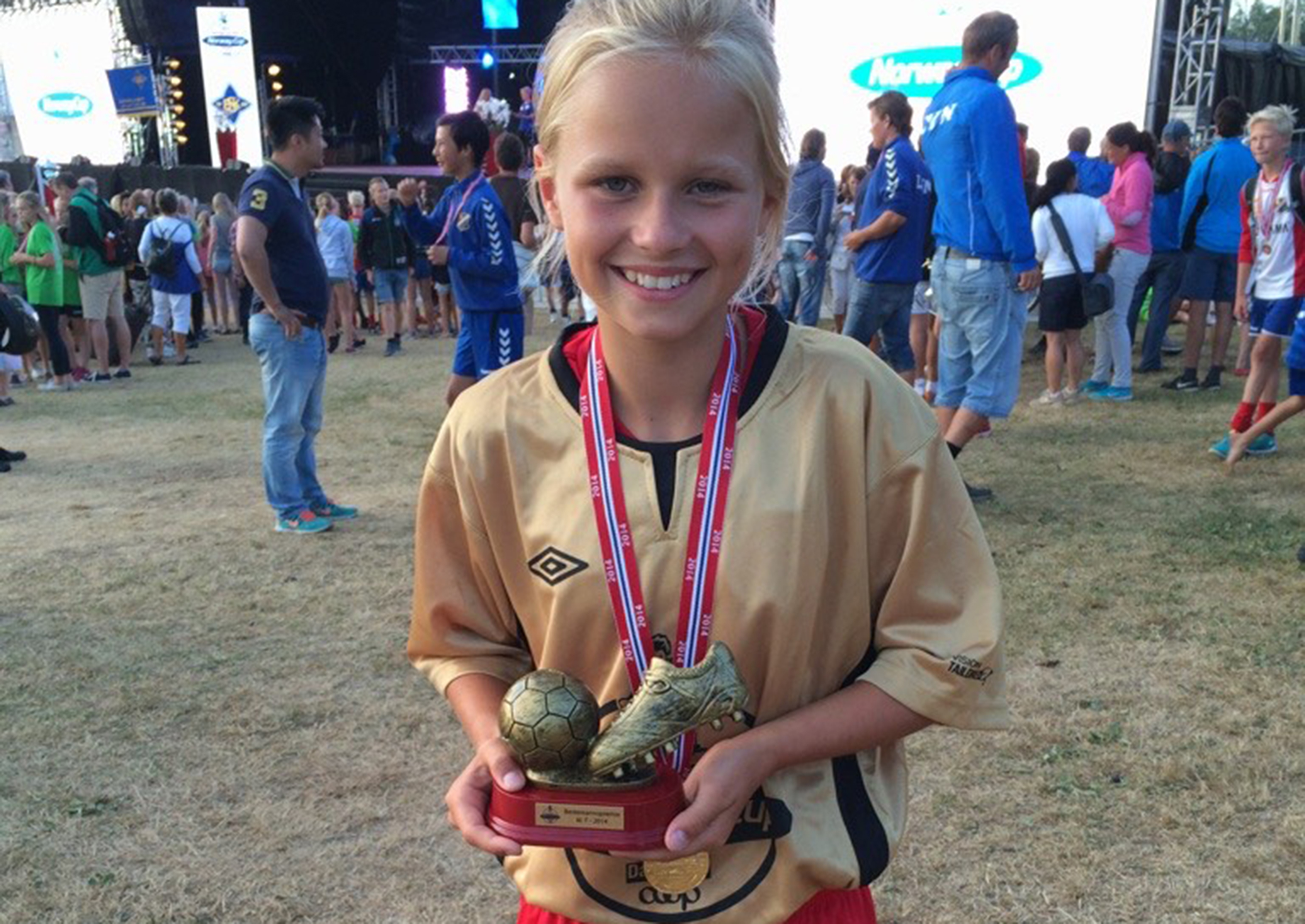
Josefine Hasbo during 2022 championships in South Carolina.
Margaret DeBruhl/Harvard Athletics
World Cup dreams come true for Harvard’s Hasbo
Danish midfielder’s quest started in second grade. It was fueled by grit, speed, agility — and a lot of time on the bus.
Josefine “Josie” Hasbo will make Harvard history this year as the first player from the women’s soccer team to represent her home country — Denmark — at the FIFA Women’s World Cup. The rising junior’s first Cup game is Friday against China in Perth, Australia.
While growing up in Rungsted Kyst, Denmark, Hasbo, 21, dreamed of playing in the World Cup. She got her start on a local team in second grade and worked her way through club teams up to the Danish national team four years ago.
“[Soccer] has been such a huge part of my life,” she said.
Recounting when she first heard the big news, the Crimson midfielder smiles wide over Zoom — excitement radiating through the screen. She said she was on the exercise bike before practice when her National Team coach came over and started casually talking about some tactical elements.
“And then suddenly, he looked at me and was like, ‘You know that you are selected [for the World Cup], right?’”
She had to delay her celebration because the official roster had not yet been released to the team.
“I was smiling all over my face, and wanted to call my family and my boyfriend to let them know that Australia was the next destination,” she said. “It’s a moment I’ll look back on and be grateful for getting the message in such a calm setting, with no choice but to just feel it.”
After training, Hasbo FaceTimed her parents, siblings, and boyfriend. “They’ve been part of this journey last couple of months.”

Hasbo’s soccer journey started in the second grade. At age 11, she begged her parents to let her join a team two hours away by bus.
Courtesy of Josefine Hasbo
Hasbo first set her sights on professional-level soccer after joining her local club team. At age 11, she begged her parents to let her join a team that would allow her to move up in the soccer world. The team — almost two hours away by bus — led to more teams, and further development and matches.
“I look back on those years as very enjoyable, but they also required a lot of planning and commitment to do homework on the bus, to training while aligning expectations with my school about absences due to my camps with the youth national teams and so forth,” Hasbo said.
At just 18 years old, she got the call to play with the Danish national team.
“I’ve been very lucky to have such a strong network of support from my family and coaches. Pursuing a ‘dual-career’ at that age, you learn to optimize your time and ask for help. I realized early on the significance of finding a balance that enabled me to maintain a social life beyond my studies and soccer while staying committed to my goals as a player.”
“Her ability to cover ground and go box-to-box are second to none. She also has a really unique ability to understand time and space, to be able to get out of very tight situations, and almost think two plays ahead.”
Chris Hamblin, Harvard’s Branca Family Head Coach
Harvard, a school she never dreamed she’d attend, emerged as a possibility after she played a high school tournament in Dallas — her first time in the U.S.
“My mother considered the trip quite expensive, so we joked that it could be an investment since we knew from other players that there might be scouts at the tournament,” Hasbo said.
And she was right. Harvard’s associate head coach Mike Calise was there. He approached Hasbo and started a yearslong effort to bring her to Cambridge.
The economics concentrator with a secondary in psychology remembers jumping at the chance to play for Harvard. It was an “opportunity to continue a dual career and get the best of both worlds.”
Harvard’s Branca Family Head Coach Chris Hamblin said the College has been lucky to have her. “I’m such a proud coach and we’re going to be cheering her on every step of the way.”
Hamblin said that Hasbo’s mental and physical fitness is sure to help Denmark.
“From a cardiovascular standpoint, her ability to cover ground and go box-to-box are second to none,” he said. “And then she also has a really unique ability to understand time and space, to be able to get out of very tight situations, and almost think two plays ahead. And I think one of the reasons for that is being smaller in stature, she tried to problem-solve in different ways.”
Hasbo, who has been in and out of training camps since September, said she expects the World Cup to be challenging and exciting.
“I hope it’s going to be a defining moment for my growth as a player and advancement of women’s soccer. I’m optimistic that the tournament will draw positive attention to the women’s game and inspire the next generation to play soccer,” Hasbo said.
This Women’s World Cup is set to be the biggest women’s sporting event in history. The opening game featuring Australia and Northern Ireland took place in front of 80,000 people, and the tournament has already sold more than 1 million tickets. “As a player, I find it incredibly exciting to be part of this momentous development,” Hasbo said.
Hasbo is already in Australia to watch the games. On July 28, Denmark will meet England in Sydney, and on Aug. 1 play Haiti, back in Perth.







